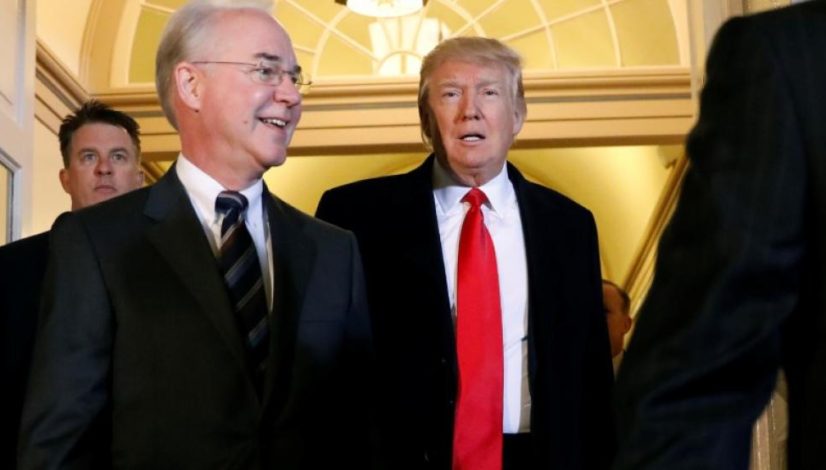Has Trump Hit the Wall Over the GOP Health Care Bill?
One big take-away from James Comey’s testimony before the House Intelligence Committee is that the FBI is investigating whether members of the Trump campaign colluded with Russia. The other? That Americans no longer trust America’s political leaders or intelligence organizations. As the FBI Director answered questions about Russia’s interference in our election and President Trump’s claims that he was wiretapped by President Obama, angry viewers across the political spectrum vented on Twitter and Facebook, charging Comey with lying and retracing the unresolved arguments of last year’s campaign.
For instance: “Hey Comey, Trump Doesn’t Know Putin, but Hillary Sold the Russians Uranium for millions. She is the real Friend of Putin.” Or, “The #ComeyHearing was a game-changer in how 2016 is perceived. Had the fact below been known, Hillary would likely be president.” Not much listening; minds made up.
Those on the right doubt there is “no evidence” that the Obama White House conducted surveillance on the Trump campaign. They point to The New York Times’ piece on January 20 claiming that “American law enforcement and intelligence agencies are examining intercepted communications and financial transactions as part of a broad investigation into links between Russian officials and associates of President-elect Trump….”
That story ran with this headline: “Wiretapped Data Used in Inquiry of Trump Aides.” Given Donald Trump’s propensity for sloppiness, many supporters interpret his accusations as based on this report of eavesdropping and surveillance. Note: The original headline appeared only in the print edition of The New York Times.
Meanwhile, Hillary supporters can’t imagine there’s “no evidence” of collusion, as any number of intelligence chiefs have claimed, between people in Donald Trump’s camp and Moscow. After all, there are numerous reported links between Russians and various people circling Trump Tower, and several instances of people like Michael Flynn and Attorney General Jeff Sessions seemingly lying about those contacts.
Sadly, neither side of the political spectrum believes FBI Director James Comey, and neither right nor left is confident in the integrity of the Congressional committee conducting the inquiry. As one person tweeted: “This will be marked in American history as a sad period of time where the NSA, FBI and CIA simply can no longer be trusted.” This is a disaster for our country.
How did we get here?
Baby Boomers learned to be skeptical of our elected officials early on when they listened to preposterous and false accounts of victories during the Vietnam War. So outlandish were the nightly claims of progress by our leaders – thousands of the enemy killed each night while all our troops were safe and sound – that they and those promulgating them in the major news networks became objects of ridicule.
But what about young people, a majority of whom, we are told, don’t think Donald Trump is the legitimate president? How did they become so cynical?
The exposed lies of recent years – revelations that have often come through email hacks or WikiLeaks – hasn’t helped. Finding that the Bush administration misled the public about WMD in Iraq or that James Clapper lied about widespread NSA spying or that iPhones aren’t secure or that the DNC conspired against Bernie Sanders or that you can’t really keep your doctor – these discoveries, and the fact that last year’s campaign featured two candidates with record low trustworthiness, have soured millennials. You can’t blame them.
America is hurting, divided and angry. This is not “fake news”; the polarization in Congress is real, as is the consequent inability to come together and solve our nation’s challenges. The media is part of the problem. A recent CBS News poll indicated that 60 percent of the country views the mainstream news media as inaccurate. Not just wrong-headed, but wrong. That’s new.
Distrust of the mainstream media has driven millions of jaded Americans to Facebook and Twitter for information, exacerbating the problem. Clicking on such sites allows a retreat to our ideological comfort zones, reading only what we agree with and accepting only those facts that fit our perspective.
Social media is not only lopsided but full of misinformation. This is a serious issue; educators are so concerned about the impact of news gathered from social media sites that they are teaching sixth-graders in Coney Island how to distinguish “fake” news from the real thing. College students are being tutored on the topic as well. Merrimack College associate professor Melissa Zimdars compiled a list of “fake news sites”, which was then picked up and recommended to Harvard students as part of a library guide on “Fake News, Misinformation, and Propaganda.”
The only problem? The list included many right-leaning but respected conservative news organizations including The Daily Caller, The Washington Examiner, and The Weekly Standard. Left-leaning groups like Salon or Vox were not included. Ms. Zimdars was immediately accused of generating – you guessed it – fake news, and took the list down.
Where do we go from here? President Trump needs to step up his game – he must set the tone and demand that others respond in kind. He must swear off issuing incredible charges and claims. He doesn’t need hyperbole; his message is strong and appeals to millions. He is new to public office, and as such not yet convinced that his every utterance will be taken at face value. It will, and he needs to rein in his asides and one-liners that he considers clever but that others use to eviscerate him. And he needs to curb the tweeting. A recent CBS survey showed that most damaging to his support today is not his healthcare bill or even his suspected ties to Russia; rather, it is his tweeting.
And the media should declare a cease-fire. Of course, they should criticize Trump when appropriate, but more balanced coverage might lower the nation’s temperature. Last weekend the Financial Times wrote a favorable editorial commending President Trump for raising optimism and “animal spirits”; it was, perhaps, the first liberal newspaper to acknowledge any single positive outcome of Trump’s 50 days in office. A welcome start.
Published here.



